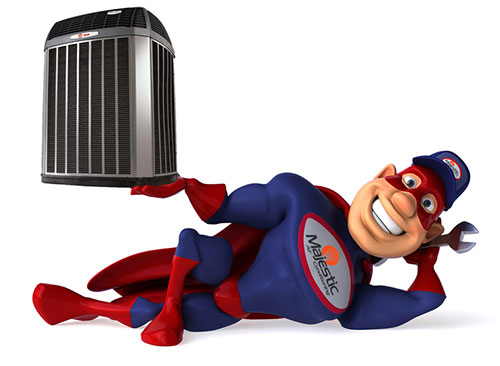HVAC Glossary
Common Terms in Residential HVAC
When you are looking at repairing your HVAC system or considering replacing your aging system, it helps to know the terminology your Majestic AC Comfort Consultant is using. Even though we make every effort to ensure you understand every aspect of the services and products we provide, it may give you better understanding when you look at it on our HVAC glossary.
Air Handler
- The Indoor Workhorse: The air handler is a large, box-like unit that’s a key part of your indoor HVAC system. It usually lives in your attic, basement, or a dedicated closet.
- Circulator and Conditioner: The air handler’s main job is to circulate air throughout your home, while also participating in the heating or cooling process.
- Works in Tandem: The air handler is almost always paired with an outdoor unit – either a heat pump or an air conditioner.
Key Components of an Air Handler:
- Blower Motor: This powerful fan pulls in air from your home via the return ducts, and then pushes it back into your living space through the supply ducts.
- Evaporator Coil: This is where the refrigerant from your outdoor unit either absorbs heat (cooling mode) or releases heat (heating mode, with a heat pump).
- Air Filter: This traps dust, allergens, and other particulates to help improve your indoor air quality.
- Expansion Valve: This device controls the flow of refrigerant in the system.
- Condensate Drain Pan: The evaporator coil can create condensation, and this pan catches the water safely.
Annualized Fuel Utilization Efficiency (AFUE)
- Efficiency Rating: AFUE is a percentage that measures the efficiency of heating equipment that burns fuel, like furnaces and boilers.
- What It Means: The AFUE tells you how much of your fuel is actually converted into usable heat for your home, with the remainder lost as waste. For example, a furnace with an 80% AFUE converts 80% of its fuel into heat, while 20% is lost through exhaust fumes, design inefficiencies, etc.
- Higher is Better: A furnace with a higher AFUE rating is more efficient, meaning it will use less fuel and ultimately lower your energy bills.
Why AFUE Matters
- Energy Savings: Furnaces and boilers are some of the biggest energy users in your home. A high-efficiency system (90%+ AFUE) can significantly reduce your annual heating costs.
- Environmental Impact: Higher AFUE appliances use fuel more efficiently, translating to reduced greenhouse gas emissions.
British Thermal Units (BTU)
- A Unit of Heat Energy: A BTU is a basic unit used to measure heat energy.
- Definition: One BTU is the amount of heat energy required to raise the temperature of one pound of water by one degree Fahrenheit (at a standard atmospheric pressure).
- Everyday Example: Think about the heat released by a single lit match – that’s roughly the equivalent of one BTU.
Why are BTUs Important?
BTUs are used in various applications, particularly when it comes to measuring the energy output or heat transfer capabilities of devices:
- HVAC: Air conditioners, furnaces, and heat pumps are all rated in BTUs. This tells you their heating or cooling capacity (often expressed as BTUs per hour).
- Appliances: Gas stoves, water heaters, and other fuel-burning appliances may have their energy input or output measured in BTUs.
- Fuels: Natural gas, propane, and other fuels are often compared using BTUs to indicate their energy content per unit volume or weight.
Central Air-Conditioning
- Whole-Home Cooling: Central air conditioning (AC) is a system that cools and dehumidifies air throughout an entire house or building, as opposed to a window unit that only cools a single room.
- Connected System: It utilizes a network of ducts, fans, and specialized components to distribute cool air to all living spaces.
Key Components of a Central AC System:
- Outdoor Unit (Condenser):
- Contains the compressor, which raises the pressure and temperature of the refrigerant.
- Houses the condenser coil, where the refrigerant releases heat to the outside air.
- Includes a fan to help expel the heat.
- Indoor Unit (Evaporator):
- Typically located within a furnace or an air handler unit.
- Contains the evaporator coil, where the refrigerant absorbs heat from the indoor air, cooling it.
- Houses a blower fan to circulate the cooled air.
- Ductwork: A system of connected ducts that carry cool air to your rooms and return warm air to the indoor unit.
- Refrigerant: A specialized chemical that cycles between the indoor and outdoor units, absorbing and releasing heat.
- Thermostat: The control center where you set your desired temperature and manage the system.
Coils
- Tubing Networks: Coils are essentially a series of connected tubes (usually made of copper or aluminum) that are designed to facilitate heat transfer.
- Refrigerant Carriers: Inside these tubes flows a refrigerant, a specialized substance that can change between liquid and gas states, absorbing and releasing heat in the process.
Types of Coils in HVAC Systems
Evaporator Coil
- Location: Found inside your home, typically in the air handler or attached to the furnace.
- Function: This is where the refrigerant absorbs heat from the air passing over it, effectively cooling your home’s air. Think of it as the “cold” coil.
- Appearance: Often A-shaped with fins to increase surface area for better heat transfer.
Condenser Coil
- Location: Part of the outdoor unit of your air conditioner or heat pump.
- Function: The condenser coil is where the refrigerant releases the heat it absorbed from your home into the outside air. Think of it as the “hot” coil.
- Appearance: Can be a large coil that wraps around the sides of the outdoor unit, also with fins for heat exchange.
Why are Coils Important?
- The Core of Heat Exchange: Evaporator and condenser coils are the heart of your HVAC system’s cooling and heating (in the case of heat pumps) process. Without them, the system wouldn’t be able to transfer heat effectively.
- Impact Efficiency: The cleanliness and condition of the coils directly influence your system’s efficiency. Dirty or damaged coils hinder heat transfer, making your HVAC work harder and costing you more in energy bills.
Compressor
- Main Function: The compressor is a powerful pump that’s responsible for circulating refrigerant throughout your air conditioning system. It plays a critical role in the heat exchange process that cools your home.
- Location: Housed within the outdoor condenser unit of your air conditioning system.
- Looks Like: Typically a sealed, cylindrical-shaped metal component.
Why is the Compressor Important?
- Essential for Cooling: Without the compressor, the refrigerant wouldn’t be able to change states and transfer heat, meaning your AC wouldn’t be able to cool your home.
- Energy Consumption: The compressor is one of the biggest energy users within your AC system. Its efficiency will affect your energy bills.
Condenser
- Outdoor Unit: The condenser is a key component located in the outdoor portion of your air conditioning system (or heat pump).
- Heat Expeller: The main function of the condenser is to release the heat that was absorbed from your home’s air into the outside environment.
Key Components of the Condenser:
- Condenser Coil: A network of metal tubing (usually copper or aluminum) filled with refrigerant. This coil features thin fins to increase surface area for better heat exchange.
- Compressor: A pump that pressurizes the refrigerant, transforming it into a hot, high-pressure gas.
- Condenser Fan: A large fan that blows air over the condenser coil, helping to dissipate the heat from the refrigerant.
Condenser Coil
A crucial component within air conditioning systems and heat pumps. Its main function is to release the heat absorbed from inside your home into the outside environment. During the cooling process, the refrigerant travels through the system in a gaseous state after being compressed. It enters the condenser coil carrying heat pulled from your home’s indoor air. As the refrigerant passes through the condenser coil, outdoor air blows over it, helping it cool down and condense back into a liquid state.
Cubic Feet Per Minute (CFM)
- Unit of Airflow Measurement: Cubic Feet per Minute (CFM) is a unit that measures the volume of air flowing through a point in one minute.
- Imagine a Cube: Think of it as the number of imaginary one-foot cubes of air that pass through a specific point (like a duct, vent, or fan opening) within a single minute.
- Common Applications: CFM is used extensively in:
- HVAC Systems: To size fans, ducts, and calculate air changes within a room or building.
- Ventilation: Measuring exhaust fan capabilities or the amount of fresh air supply.
- Industrial Processes: Determining airflow in manufacturing or cleanroom environments.
Why is CFM Important?
- HVAC Design: Selecting the correct size of fans, ducts, and other components depends on knowing the required CFM to achieve desired airflow and heating/cooling capacity.
- Indoor Air Quality: CFM affects air changes per hour, a crucial factor in maintaining healthy air quality by diluting pollutants and contaminants.
- Equipment Efficiency: Appliances and machinery that rely on airflow (like dust collectors) will have a required CFM for optimal performance.
Dehumidifier
A dehumidifier is an electrical appliance designed to reduce and control the humidity level within a designated space. It works by drawing in moist air with a fan. The air passes over chilled coils, where the moisture condenses into water droplets. This water collects in a reservoir or drains out through a hose while the drier air is then released back into the room.
Diffuser
A diffuser is a device installed at the end of ductwork and is the final outlet through which conditioned air (heated or cooled) is distributed into a room.
- Design:
- Typically made of metal or plastic.
- They feature vanes or blades that can be adjusted to direct the airflow into desired patterns.
- Function: Diffusers play a significant role in:
- Air Distribution: They help to evenly spread the air throughout the space, avoiding hot or cold spots.
- Comfort: By controlling airflow direction, they can be positioned to prevent drafts and blowing directly on occupants.
- Noise Reduction: Some diffusers help to minimize the sound of rushing air as it enters the room.
Drain Pan
Location: A drain pan is situated underneath the evaporator coil within your air conditioning unit or heat pump (in heat pump mode). It’s usually found in the indoor portion of the system.
Material: Drain pans are typically made of sheet metal, although some newer models may be made of corrosion-resistant plastic.
Purpose: The drain pan’s primary function is to collect condensation that forms on the evaporator coil during the cooling process. Here’s how it works:
Condensation: When warm, humid air passes over the cold evaporator coil, the moisture in the air condenses into water droplets, like a cold beverage on a hot day.
Collection: The drain pan catches this condensation, preventing it from dripping into your home or the internal components of the HVAC system.
Drainage: A drain line is connected to the drain pan, allowing the collected water to be safely channeled away. This water usually drains outdoors or into a designated drain within your home.
Energy Efficiency Ratio (EER)
What it measures: EER is a metric used to evaluate the energy efficiency of cooling appliances, primarily air conditioners (both window and central units) and heat pumps while in cooling mode.
How it’s calculated: EER is calculated by dividing the cooling output in British Thermal Units per hour (BTU/h) by the power input in watts (W) at a specific set of conditions.
Standard Conditions: To accurately compare appliances, EER is usually measured under the following standardized conditions:
- Outdoor temperature: 95°F (35°C)
- Indoor temperature: 80°F (27°C)
- Relative humidity: 50%
The Value of EER: A higher EER indicates a more energy-efficient appliance. In other words, a higher EER unit can provide the same amount of cooling using less electricity. This translates to lower energy bills and a reduced environmental impact.
Energy Star®
Energy Star® is a voluntary program established by the United States Environmental Protection Agency (EPA) in 1992, with the goal of promoting energy efficiency and reducing greenhouse gas emissions. The Energy Star program provides energy efficiency ratings and certifications for various products and buildings, helping consumers and businesses identify energy-efficient options that can save money on energy bills and contribute to environmental sustainability. Products and buildings that meet Energy Star’s stringent energy efficiency criteria are awarded the Energy Star label, making them easily identifiable to consumers seeking environmentally friendly choices. The program covers a wide range of products and equipment, including appliances, electronics, heating and cooling systems, lighting, commercial buildings, and industrial facilities.
An evaporator coil is a key component in air conditioning and refrigeration systems. It is typically located indoors, within the air handler unit or attached to the furnace, and is responsible for absorbing heat from the air or refrigerant passing through it.
Overall, the evaporator coil plays a crucial role in the cooling process of air conditioning and refrigeration systems, helping to maintain comfortable indoor temperatures and humidity levels.
Expansion Valve
In HVAC (Heating, Ventilation, and Air Conditioning) systems, an expansion valve is a crucial component that regulates the flow of refrigerant into the evaporator coil. Its primary function is to control the amount of refrigerant entering the evaporator coil, thus maintaining proper cooling capacity and efficiency within the system.
In the context of HVAC systems, zoning refers to the division of a home or building into multiple areas or zones, each with its own thermostat and temperature control. This allows for independent heating and cooling of different zones, based on individual preferences and needs.









